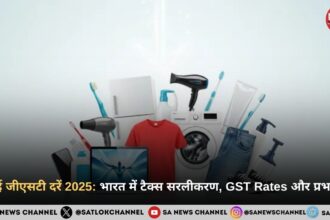Union Budget 2025: Finance Minister Nirmala Sitharaman presented the Union Budget for 2025-2026 on February 1, 2025, outlining the government’s vision for a Viksit Bharat (Developed India) by 2047. The budget focuses on inclusive growth, employment generation, agricultural prosperity, and technological innovation, while addressing global economic challenges. Here’s a breakdown of the key highlights and what they mean for ordinary citizens:
- Key Themes of the Union Budget 2025
- Union Budget 2025: Major Announcements and Their Impact
- 1. Agriculture and Rural Development
- 2. Union Budget 2025: MSMEs and Employment
- 3. Healthcare and Education
- 4. Union Budget 2025: Infrastructure and Urban Development
- 5. Energy and Sustainability
- 6. Taxation Reforms
- 7. Union Budget 2025: Innovation and Technology
- 8. Exports and Global Integration
- Fiscal Discipline
- Conclusion on Union Budget 2025
- FAQs: Union Budget 2025-2026
- 1. What are the key highlights of the Union Budget 2025-2026?
- 2. How does the budget benefit the middle class?
- 3. What measures are introduced for farmers?
- 4. How does the budget support MSMEs?
- 5. What are the healthcare initiatives in the budget?
- 6. How does the budget promote clean energy?
- 7. What are the key infrastructure projects announced?
- 8. How does the budget support startups and innovation?
- 9. What are the key export promotion measures?
- 10. How does the budget ensure fiscal discipline?
- Connect With Us on the Following Social Media Platforms
Key Themes of the Union Budget 2025
1. Inclusive Development : The budget aims to uplift all sections of society, especially the poor, youth, farmers, and women.
2. Economic Growth : Focus on boosting manufacturing, exports, and private sector investments.
3. Sustainability : Emphasis on clean energy, climate resilience, and sustainable agriculture.
4. Ease of Living : Measures to enhance household spending power, healthcare, and education.
Union Budget 2025: Major Announcements and Their Impact
1. Agriculture and Rural Development
– Prime Minister Dhan-Dhaanya Krishi Yojana : A new program to boost agricultural productivity in 100 low-productivity districts. It will focus on crop diversification, irrigation, and post-harvest storage, benefiting 1.7 crore farmers .
– Mission for Aatmanirbharta in Pulses : A 6-year mission to achieve self-sufficiency in pulses like Tur, Urad, and Masoor. This will ensure better prices for farmers and reduce India’s dependence on imports.
– Makhana Board in Bihar : To promote production, processing, and marketing of makhana (foxnuts), creating opportunities for farmers and FPOs.
– Kisan Credit Card (KCC) Limit Increased : Loan limits under KCC raised from ₹3 lakh to ₹5 lakh, benefiting 7.7 crore farmers , fishermen, and dairy farmers.
Impact : Farmers will see improved incomes, better access to credit, and reduced post-harvest losses. Rural economies will thrive with increased investment in infrastructure and skilling.
2. Union Budget 2025: MSMEs and Employment
– Revised MSME Classification : Investment and turnover limits for MSMEs increased to encourage growth and job creation.
– Credit Guarantee Enhancement : Credit guarantee cover for micro and small enterprises raised from ₹5 crore to ₹10 crore, enabling additional credit of ₹1.5 lakh crore over 5 years.
– Credit Cards for Micro Enterprises : Customized credit cards with a ₹5 lakh limit for micro-enterprises, with 10 lakh cards to be issued in the first year.
– Focus on Labour-Intensive Sectors : Special schemes for footwear, leather, and toy industries to boost exports and create 22 lakh jobs .
Impact : MSMEs, the backbone of India’s economy, will get easier access to credit and technology, fostering entrepreneurship and employment.
Also Read: Budget 2025: Understand What’s Coming Tomorrow in Simple Language
3. Healthcare and Education
– Day Care Cancer Centres : 200 centres to be set up in district hospitals in 2025-26, with a goal to establish them in all districts within 3 years.
– Medical Education Expansion : 10,000 additional medical seats to be added in 2025-26, aiming for 75,000 new seats in 5 years.
– Atal Tinkering Labs : 50,000 labs to be set up in government schools to foster innovation and scientific temper among students.
– Bharatiya Bhasha Pustak Scheme : Digital Indian language books to be made available for school and higher education.
Impact : Improved healthcare access, especially in rural areas, and better educational opportunities for students across the country.
4. Union Budget 2025: Infrastructure and Urban Development
– Jal Jeevan Mission Extended : The mission to provide tap water to all rural households extended until 2028, with a focus on quality and sustainability.
– Urban Challenge Fund : A ₹1 lakh crore fund to support urban infrastructure projects, including water, sanitation, and redevelopment.
– UDAN Scheme Expansion : Regional air connectivity to be expanded to 120 new destinations, benefiting hilly and North Eastern regions.
Impact : Better infrastructure will improve quality of life, boost tourism, and create jobs in construction and related sectors.
5. Energy and Sustainability
– Nuclear Energy Mission : Aim to develop 100 GW of nuclear energy by 2047, including Small Modular Reactors (SMRs).
– Clean Tech Manufacturing : Support for domestic manufacturing of solar PV cells, EV batteries, and wind turbines.
– Maritime Development Fund : A ₹25,000 crore fund to boost shipbuilding and promote India’s maritime sector.
Impact : Clean energy initiatives will reduce India’s carbon footprint and create opportunities in green technology.
6. Taxation Reforms
– Personal Income Tax Relief :
– No tax on income up to ₹12 lakh under the new tax regime.
– Revised tax slabs:
– 0-4 lakh: Nil
– 4-8 lakh: 5%
– 8-12 lakh: 10%
– 12-16 lakh: 15%
– 16-20 lakh: 20%
– 20-24 lakh: 25%
– Above 24 lakh: 30%
– Simplified TDS/TCS : Thresholds increased for TDS on rent (₹2.4 lakh to ₹6 lakh) and interest for senior citizens (₹50,000 to ₹1 lakh).
Impact : Middle-class taxpayers will have more disposable income, boosting consumption and savings.
7. Union Budget 2025: Innovation and Technology
– Deep Tech Fund of Funds: To support next-generation startups in cutting-edge technologies.
– National Geospatial Mission: To modernize land records and urban planning using geospatial data.
– Centre of Excellence in AI for Education : A ₹500 crore initiative to integrate AI into education.
Impact: India will emerge as a global hub for innovation, creating high-skilled jobs and attracting investments.
8. Exports and Global Integration
– Export Promotion Mission: To boost exports by addressing non-tariff barriers and providing credit support to MSMEs.
– BharatTradeNet: A digital platform for trade documentation and financing, simplifying cross-border trade.
– Global Capability Centres (GCCs): A national framework to promote GCCs in tier-2 cities, creating jobs and boosting local economies.
Impact: Indian exports will become more competitive, and integration with global supply chains will accelerate.
Fiscal Discipline
– Fiscal Deficit : Estimated at 4.4% of GDP for 2025-26, down from 4.8% in 2024-25.
– Capital Expenditure: ₹10.18 lakh crore allocated, focusing on infrastructure development.
Impact: Prudent fiscal management will ensure sustainable growth without excessive borrowing.
Conclusion on Union Budget 2025
The 2025-2026 budget is a forward-looking blueprint for India’s development, balancing growth with inclusivity. Key takeaways for citizens:
– Farmers and Rural India: Increased support for agriculture and rural infrastructure.
– Middle Class : Significant tax relief and better healthcare/education access.
– Youth and Entrepreneurs: More opportunities in MSMEs, startups, and skilled sectors.
– Environment: Focus on clean energy and sustainable practices.
This budget sets the stage for India to achieve its vision of becoming a $5 trillion economy and a global leader in the 21st century. As citizens, we can look forward to a brighter, more prosperous future.
FAQs: Union Budget 2025-2026
1. What are the key highlights of the Union Budget 2025-2026?
The budget focuses on inclusive growth, employment generation, agricultural prosperity , and technological innovation. Key highlights include tax relief for the middle class, support for farmers, healthcare expansion, MSME credit enhancement, and a push for clean energy.
2. How does the budget benefit the middle class?
– Tax Relief : No tax on income up to ₹12 lakh under the new tax regime.
– Revised Tax Slabs: Lower tax rates for incomes between ₹4 lakh and ₹24 lakh.
– Increased TDS Thresholds: Higher limits for TDS on rent (₹6 lakh) and interest for senior citizens (₹1 lakh).
3. What measures are introduced for farmers?
rime Minister Dhan-Dhaanya Krishi Yojana: Boosts productivity in 100 low-productivity districts.
– Mission for Aatmanirbharta in Pulses : Aims for self-sufficiency in pulses like Tur, Urad, and Masoor.
– Kisan Credit Card (KCC) Limit Increased : Loan limits raised from ₹3 lakh to ₹5 lakh.
4. How does the budget support MSMEs?
Revised MSME Classification: Higher investment and turnover limits.
– Credit Guarantee Enhancement : Guarantee cover increased from ₹5 crore to ₹10 crore.
– Credit Cards for Micro Enterprises : Customized credit cards with a ₹5 lakh limit.
5. What are the healthcare initiatives in the budget?
Day Care Cancer Centres: 200 centres to be set up in district hospitals in 2025-26.
– Medical Education Expansion : 10,000 additional medical seats in 2025-26, aiming for 75,000 new seats in 5 years.
6. How does the budget promote clean energy?
– Nuclear Energy Mission: Aims to develop 100 GW of nuclear energy by 2047.
– Clean Tech Manufacturing : Support for domestic manufacturing of solar PV cells, EV batteries, and wind turbines.
7. What are the key infrastructure projects announced?
– Jal Jeevan Mission Extended: To provide tap water to all rural households by 2028.
– Urban Challenge Fund: A ₹1 lakh crore fund for urban infrastructure projects.
– UDAN Scheme Expansion: Regional air connectivity to 120 new destinations.
8. How does the budget support startups and innovation?
– Deep Tech Fund of Funds : To support next-generation startups.
– Centre of Excellence in AI for Education: A ₹500 crore initiative to integrate AI into education.
– Extended Tax Benefits for Startups : Incorporation period extended to 2030.
9. What are the key export promotion measures?
– Export Promotion Mission: Addresses non-tariff barriers and provides credit support to MSMEs.
– BharatTradeNet: A digital platform for trade documentation and financing.
– Global Capability Centres (GCCs): Promoted in tier-2 cities to boost local economies.
10. How does the budget ensure fiscal discipline?
– Fiscal Deficit: Estimated at 4.4% of GDP for 2025-26, down from 4.8% in 2024-25.
– Capital Expenditure: ₹10.18 lakh crore allocated for infrastructure development.









